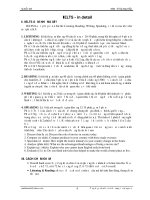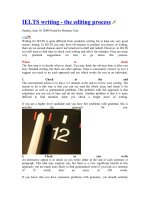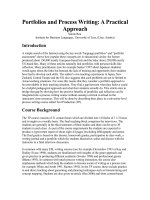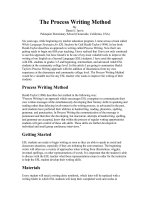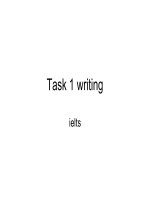Process diagram IELTS
Bạn đang xem bản rút gọn của tài liệu. Xem và tải ngay bản đầy đủ của tài liệu tại đây (840.67 KB, 15 trang )
Process Diagram
Process Diagram
• It is less common in the writing test, but
sometimes you will get an IELTS process
diagram to describe.
• Introduce the diagram
• Give an overview of the main point(s)
• Give the detail
Introduce the Diagram
• The diagram explains ........... in which .......... are
made for ......................
Provide an overview
(the number of stages in the process and how
it begins and ends)
Overall, there are ..........stages in the process,
beginning with the ............... and .............
Give the Detail
1) Time Connectors
A process is a series of events, one taking place
afer the other. Therefore, to connect your
stages, you should use ‘time connectors’.
To begin
Following this
Next
Then
After
After that
Subsequently
Finally
2) The Passive
• When we describe an IELTS process, the focus
is on the activities, NOT the person doing
them.
• When this is the case, we use the
passive voice, not the active.
Finally, the parcels are packed…
• You should spend about 20 minutes on this
task.
• The diagram illustrates the process that is
used to manufacture bricks for the building
industry.
• Summarize the information by selecting and
reporting the main features and make
comparisons where relevant.
• Write at least 150 words.
The given diagram explains the process of brick
manufacturing in different stages for the
building industries.
• The given diagram explains the process of
brick manufacturing in different stages for the
building industries.
• As is presented in the diagram, brick
production involves about 7 steps including
the digging stages to delivery stage.
• To begin, the clay used to make the bricks is dug up
from the ground by a large digger. This clay
is then placed onto a metal grid, which is used to break
up the clay into smaller pieces. A roller assists in this
process.
• Following this, sand and water are added to the clay,
and this mixture is turned into bricks by either placing it
into a mould or using a wire cuter. Next, these bricks
are placed in an oven to dry for 24 – 48 hours.
• In the subsequent stage, the bricks go through a
heating and cooling process. They are heated in a kiln
at a moderate and then a high temperature (ranging
from 200c to 1300c), followed by a cooling process in
a chamber for 2 – 3 days. Finally, the bricks are packed
and delivered to their destinations.
• You should spend about 20 minutes on this
task.
• The illustrations show how chocolate is
produced.
• Summarize the information by selecting and
reporting the main features and make
comparisons where relevant.
• Write at least 150 words.

